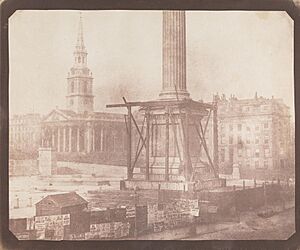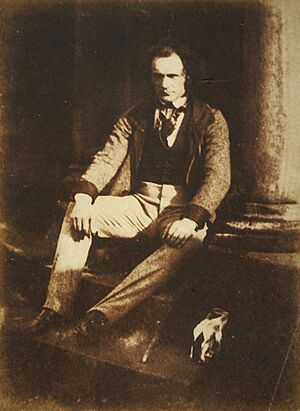Calotype facts for kids

The calotype (also called talbotype) was an early way to take photographs. It was created in 1841 by William Henry Fox Talbot. This method used paper that was specially coated with chemicals like silver iodide.
The word calotype comes from ancient Greek words. Kalos means "beautiful," and typos means "impression."
Contents
How the Calotype Process Worked
Talbot first made successful camera photos in 1835. He used paper treated with silver chloride. This paper would get darker when light hit it. This early method needed a very long time to take a picture, often an hour or more! The image slowly appeared as the paper was exposed to light.
In 1840, Talbot found a much faster way. This new method, called the calotype, needed only a minute or two of light exposure. The paper would have a very faint, almost invisible image on it. This hidden image is called a latent image.
After taking the picture, the paper was taken out of the camera. Then, special chemicals were used to make the hidden image fully visible. This was a big step forward in photography!
The calotype process used silver halide (a light-sensitive chemical) on paper. This was made by mixing chemicals like silver nitrate and potassium iodide. The paper was prepared in steps:
- First, one side of good quality paper was brushed with a silver nitrate solution.
- Then, it was dipped in a potassium iodide solution.
- After drying, the paper was ready to be used in the camera.
To develop the picture, more chemicals were brushed onto the paper. Once the image was clear, it was rinsed. Then, it was "fixed" using a chemical called sodium thiosulphate. This made sure the image would not fade when exposed to light later.
Why Calotypes Were Special
The calotype process created a negative image on paper. This negative was see-through. From this one negative, many positive prints could be made. This was a big advantage!
Another early photo method, the daguerreotype, made only one unique image. You couldn't easily make copies of a daguerreotype. But with a calotype negative, you could make as many copies as you wanted.
Often, calotype negatives were treated with wax. This made them more transparent. It also helped to hide the texture of the paper in the final prints.
Talbot was the first to use this "negative-positive" idea with paper. This method became the basis for almost all photography that came after it, before digital cameras.
Calotype's Popularity and Challenges

Even though calotypes were flexible, they didn't completely replace daguerreotypes at first. One reason was that Talbot had patented his process in England. This meant others had to pay to use it. In contrast, the daguerreotype process was made public for free in France.
However, in Scotland, where Talbot's patent didn't apply, many photographers used the calotype. Groups like the Edinburgh Calotype Club became very active. In England, the Calotype Society also formed. Talbot's patent rules were finally lifted in 1853.
Another challenge for calotypes was their image quality. Because paper was used for the negative, the texture of the paper fibers could sometimes be seen in the final prints. This made the images look a bit grainy or fuzzy. Daguerreotypes, on the other hand, were usually very sharp and clear.
Despite this, calotypes remained popular in the United Kingdom and parts of Europe during the 1850s. Many amateur photographers liked the unique look of calotypes. They also wanted to be different from commercial photographers. Later, the collodion process came along. This new method used glass negatives. It combined the sharpness of a daguerreotype with the ability to make many copies, like a calotype.
British photographers also brought the calotype to India. For example, in 1848, John McCosh took the first picture of the Maharajah Duleep Singh using this method.
See also
- Albumen print
- Ambrotype
- Collodion process
- Daguerreotype
- Tintype

